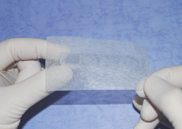|
Clean Optical Mirrors
Dust and stains on mirror surfaces can cause
scattering/loss of light and can even react with light to damage the
surfaces at a high incident laser power.
You can inspect the mirror surface for dust
and stains by holding it near a bright visible-light source. Viewing at
different angles helps to see scattering from dust and stains. The mirror
surface has to be cleaned if dust and stains are found.
You should perform the following cleaning
procedures in a clean, low-dust environment while wearing powder-free gloves
or finger cots.
1. Blowing off the mirror surface
A canister of compressed N2/clean air or a blower bulb
(http://www.adorama.com/GTRABS.html ) should be first used to blow off dust
and other loose contaminants. If a dry nitrogen line is available in the
lab, an air gun can also be used to blow away dust particles. Blow off the
surface gently. Do not blow off the mirror itself from your hand !
2. Drop and Drag Method
Hold the mirror so that the  surface
is horizontal and slightly above your fingers. Take a fresh, clean
sheet of lens tissue and place it on the surface. Make sure the lens tissue
can be drawn across the mirror surface. Next place a small drop of pure
isopropyl alcohol (IPA) on the lens tissue on top of the mirror surface. The weight of the
solvent will cause the lens tissue to come into contact with the mirror
surface. Slowly but steadily drag the damp lens tissue across the mirror
surface being careful not to lift the lens tissue off of the surface.
Continue dragging the lens tissue until it is off of the surface. surface
is horizontal and slightly above your fingers. Take a fresh, clean
sheet of lens tissue and place it on the surface. Make sure the lens tissue
can be drawn across the mirror surface. Next place a small drop of pure
isopropyl alcohol (IPA) on the lens tissue on top of the mirror surface. The weight of the
solvent will cause the lens tissue to come into contact with the mirror
surface. Slowly but steadily drag the damp lens tissue across the mirror
surface being careful not to lift the lens tissue off of the surface.
Continue dragging the lens tissue until it is off of the surface.
The amount of the solvent can be adjusted for
various mirror size so the lens tissue is kept damp for the entire drag but
there is not any visible trace of solvent on the mirror surface after the
drag is finished. Inspect the surface and repeat if necessary, but only use
each sheet of lens tissue once.
|